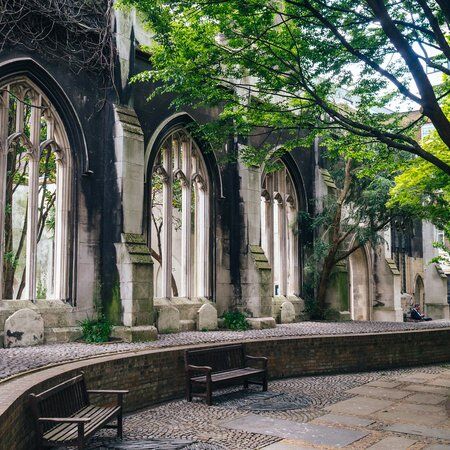In the 12th Century, when St Dunstan-of-the East was most likely built, London was a trade-hub, on the rise after the Norman conquest of 1066. A fire had recently wiped out much of the city's wooden housing, but, not to worry, this meant that they could rebuild it out of stone.
The future was bright.
Fast forward 200 years, however, and the city's prospects looked a bit more dicy.

What Could Have Been
Thanks to its large population and the burning of 'sea coal', 14th Century London was a polluted place. Its trade network was still flourishing, but disaster was on the horizon.
In 1348-9, the Black Death wiped out approximately 12.5% of its population, leaving the city devastated. We know now that it was to recover well, but what if it had failed to do so?
The ruins of St Dunstan-in-the-East give us a glimpse of one such alternate history.

History Laid To Rest
Like the rest of London, St Dunstan-in-the-East survived the Black Death and many disasters beyond it. It made it through the Fire of London, the Bubonic Plague and the English Civil War. Eventually, however, its centuries old frame was shattered by a direct hit from a German bomb.
The year was 1941. It was the height of the blitz. London was being bombed, nightly, in a campaign that would see over 1,000,000 homes destroyed. St Dunstan-in-the-East was one of its many victims.
Unlike the others, however, it was neither repaired, nor built over. It was simply let be. After over 800 years of tumult, it was allowed to become a ruin. And a garden.

War and Peace
In a city as fast-paced as London it can be hard to find a space to just breathe and reflect, but St Dunstan-in-the-East is perfect for this. From the debris of London's most horrific war, emerged one of its most peaceful spaces.

Progress Stands Still, As Nature Flourishes
The church's North and South wall still stand, survivors of the bomb and the preceding 800 years, both. Its 17th Century Tower and Steeple, designed by Sir Christopher Wren, also remain. The rest is gone, however.
Where there were once pews, an altar, an aisle, there are now plants and trees. Ivy cover the extant walls, leaving one to wonder what the rest of the city would look like were it to be left untouched by human hands.
St Dunstan-in-the-East is, in reality, still looked after by the city council, but it does nonetheless possess a strange and meditative beauty. Hidden behind modern towerblocks, in the centre of a bustling city, it brings a sharp contrast into focus. We are reminded that, in looking upon this ruined church, we are not only stealing a glimpse of our past, but of our future, too. As large and powerful as London is, nature will still outlast it. How long will it be before today's cities look like St Dunstan-in-the-East?

One More Thing...
St Dunstan, himself, is best remembered today in the superstition that horseshoes bring good luck. Legend has it that he nailed one to the Devil's cloved hoof, before making him swear that he'd never enter a place with a horseshoe hanging above its door. They have been symbols of good fortune ever since.
Interested in finding more places like this? Try one of our London Quiz Walks - untangle cryptic clues as a team, as you are taken on a journey to the most unique, unusual and bizarre corners of London.
Read more about hidden gardens with fascinating stories to tell in our posts on NYC's Vale of Cashmere, Melbourne's Alfred Nicholas Gardens, Manchester's Fletcher Moss Park and London's Greenwich Park.













